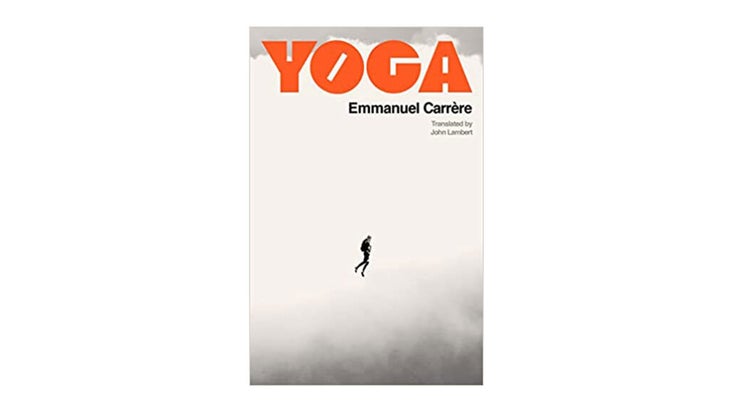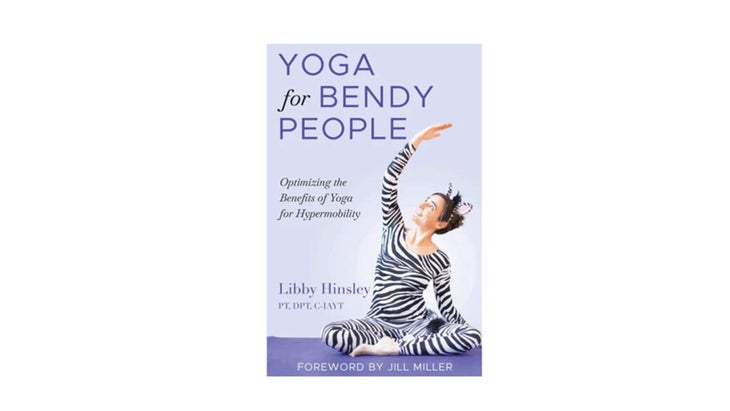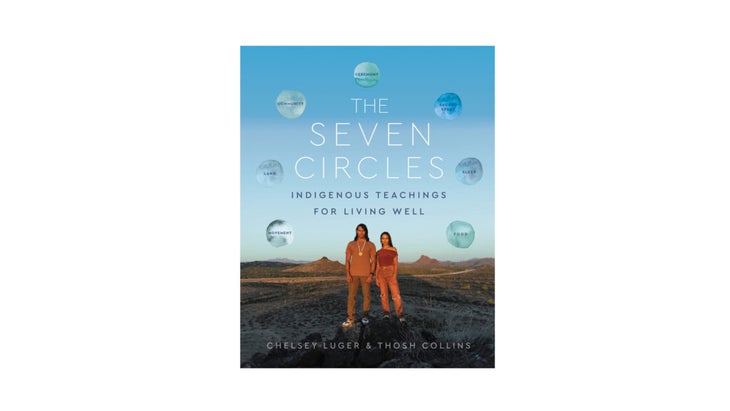Heading out the door? Read this article on the new Outside+ app available now on iOS devices for members! Download the app.
One good thing about living in contemporary times: There is so much information available to us instantaneously. Although as much as we appreciate the immediate access and take-it-anywhere-ness of digital content, sometimes we want to linger as we take a deep dive on a subject or revel in the writing of an author who has wisdom to share.
There’s been no shortage of wisdom in the books we were drawn to in 2022. Some pointed us toward our journey. Others encouraged us along the way. As we explored their various themes, we were reminded that a book doesn’t have to talk about yoga to embrace the essence of the practice. Following are the books that inspired us the most.
The 10 books we couldn’t put down this year

Rest + Calm: Gentle Yoga and Mindfulness Practices to Nurture and Restore Yourself
By Paula Hines
Hines, a London-based restorative teacher and OM Yoga magazine columnist, shares practical guidance on how to cultivate rest and calm into our busy days.
The first section of her book, Rest, includes detailed instructions on how to get into restorative poses. Her in-depth instructions are illustrated by images that give just enough visual guidance for approaching each pose. The section also includes “rest sessions” that offer “poses and sequences you can turn to when you feel in need of some restorative rescue.” Here, you’ll find sequences to address depression, grief, anger, anxiety, as well as insomnia, menopause, endometriosis, and other emotional and physical conditions.
The second section, Calm, examines various ways to bring ease to everyday situations using practical tips and research-backed ideas. Hines offers grounding techniques such as self touch, and explains the benefits of using blankets, sandbags, and other props to apply gentle weight to your body. Pranayama, mudra practice, body scans, and yoga nidra are among the calming practices she recommends. And she suggests that we embrace new habits that foster a calmer existence, including choosing mono-tasking over multi-tasking, and “putting the day to bed” by incorporating mindful rituals for end-of-day activities.

You Are More Than You Think You Are: Practical Enlightenment for Everyday Life
By Kimberly Snyder
A self-described holistic wellness expert, Snyder is the host of the Feel Good Podcast and founder of the lifestyle brand Soulluna. She’s written best-selling books including Radical Beauty with Deepak Chopra. As such, she has plenty of influencer cred. But her approach to this book is firmly rooted in the teachings of Paramahansa Yogananda, the first Indian yogi to settle in America. His quotes and instructions are interspersed throughout the book in every chapter and almost every page.
One of his sayings was: “You don’t have to acquire anything. The gold of the soul is right there with you.” Snyder attempts to draw out the precious substance of our lives and help readers along the path to the power of the True Self.
Each chapter is an extended affirmation–you are fearless, you are love, you are whole, you are magnetic… you get the picture. Snyder uses ancient texts and contemporary situations to support her encouraging words of guidance. Interspersed are practical exercises for deepening the affirmation. She offers guidance on how to use pranayama, mantra, and meditation to support these affirmations and urge her readers along the path to recognizing our True Self.

Your Yoga series
By Bernie Clark
“The human body and the human experience of our body are complex, vast, and varied,” begins Your Body, Your Yoga. “It will never be possible to reduce the full range of variation and its implications for our yoga practice into one book.”
So Clark wrote three. The series began with Your Body, Your Yoga, which was published in 2016, followed by Your Spine, Your Yoga in 2018, and Your Upper Body, Your Yoga earlier this year.
A longtime student of yoga and meditation, Clark began to teach in 1998. Since then, he has continually explored and researched the interrelationship between yoga and science. He shares his findings in a manner that is suggestive rather than prescriptive.
The books take what Clark refers to as a “reductionist” approach to the different anatomical elements while remaining respectful to the practice and experience of yoga. What results are beautifully and brilliantly detailed books with nuanced explanations and annotated illustrations of the body and movement through the lens of poses.
Each book guides students and teachers through the intricacies, dangers, and variations inherent in the practice. And the emphasis he places on the experience of the student is apparent in the advice and cues he offers to teachers.
The books are perhaps best relied on as references, not as read-throughs. Yoga teachers shouldn’t skip “How to Read This Book” at the outset of Your Body, Your Yoga, and the sidebars, charts, and notes are essential reads.
$60.97 for the series of three books at Amazon

Yoga
By Emmanuel Carrère (translated by John Lambert)
Carrère’s intention, as he repeatedly explains in this work, was to write “an upbeat, subtle little book on yoga.” He had anticipated it being a simple exploration of his decades of experience with the physical and meditative aspects of the practice. What resulted is a meandering and complex exploration of the unraveling of his life over the last four years.
Yoga begins with a 134-word first sentence taking readers back to just before Carrère began a silent meditation retreat. That introduction divulges pretty much everything you need to know about where the author will take you in the book. It’s how he does so that is the book’s draw.
The New York Times details the celebrated French writer’s writing style as “marrying deep reporting to scholarly explorations of theology, philosophy, psychology, personal history and historiography.” Yoga is a melding of memoir and novel in which Carrère offers his perspective, musings, and questions on self, love, loss, morality, and a diagnosis of bipolar disorder. As he does so, Carrère draws on all manner of disciplines, including Chinese martial arts, Greek philosophy, meditation, even hiking,
With only occasional paragraph breaks, the book takes the reader along as witness to the writer’s search for lessons from yoga and meditation and his attempt to understand life, its entanglements, and the sometimes brutal lessons that ensue.

The Seven Ways of Ayurveda: Discover Your Dosha, Tap into Your Strengths, Thrive in Work, Love, and Life
By Sarah Kucera
Kucera introduces readers to “yoga’s sister science,” the ancient Indian medical system that promises health benefits for body and mind. The introduction covers the basics of Ayurveda—including an overview of the significance of the elements (earth, air, fire, water, ether) and the gunas. From there, the book focuses on the doshas–the energies that contribute to our unique personality and guides how we operate in the world. “Our inherent dosha, or prakriti, serves as our home base. It’s the place we feel the healthiest and our strongest ability to thrive,” she writes.
While people with a basic understanding of Ayurveda are familiar with the three basic doshas–kapha, pitta, and vata—Kucera takes the explanation further to delve into the dosha “hybrids” that can influence our wellbeing. “You may be dual doshic, meaning two doshas are strongly expressed, and the third is far less detectable,” she writes. Tridoshic types are rare, she says, but she addresses the traits of those who exhibit all the doshas equally. The chapters focus on how each dosha type tends to think, communicate, and handle stress. She also describes the light and shadow sides–the gifts and challenges of each type. Readers can take a simple dosha quiz that allows them to identify theirs, as well as tips to know whether they are out of balance.
In the third part of the book, Kucera shows how doshas influence our interactions with the world around us, and applies this understanding to how we live with, work with, and love one another across our doshic differences. What are pittas like as children versus adults? What’s the best way to motivate a kapha type at work? How do you plan a dream date for a vata? Finally, there’s a chapter on how to help any dosha type succeed in life. “No matter where you are in your dosha journey, there are always ways to thrive!” she writes.

Yoga for Bendy People: Optimizing the Benefits of Yoga for Hypermobility
A self-described “bendy person,” Hinsley practiced yoga for years before understanding that her extreme flexibility on the mat was related to her baffling pain and other physical symptoms she experienced each day. She was eventually diagnosed with Ehlers-Danlos Syndrome, a group of connective tissue disorders.
Hypermobility has begun to be more commonly discussed and diagnosed, but many who are drawn to yoga precisely because of their innate flexibility are still uninformed about its prevalence and risks. Hinsley, a physical therapist and yoga therapist, addresses this “invisible disability” with frankness and humor, first in the telling of her story and then in her methodical and thorough explanations of ways that students and teachers of yoga can safely navigate it.
Hinsley’s approach is designed to help anyone learn how yoga can support, rather than exacerbate, the symptoms of hypermobility through variations and cues on how to engage their body in safer, if unfamiliar, ways. Those who need anatomical insights and encouragement will find it in abundance in this book.

And Bloom: The Art of Aging Unapologetically
By Denise Boomkens
Boomkens, a former fashion model and photographer, felt a lot of things upon entering her 40s. Refusing to let age define her appearance or her sense of self, she set out to ensure that she didn’t disappear into the background. Thus began And Bloom, a blog and online community dedicated to aging gracefully and embracing life without fear.
“I started to miss inspiring websites with coolness and authenticity towards aging,” she explains. So she turned her love for “photography, fashion, lifestyle, and spiritual consciousness” into a counterpoint for society’s “distorted perception of aging.” She achieves this through photographs and profiles of other women and their real, relatable, and often rebellious thoughts, actions, frustrations, and approaches to life.
The book compiles these stories—full of sass and class, flamboyancy and revelry—and allows readers a glimpse into the beautiful visages of those who are not yet done experiencing life in all its grandeur. The concept of mindfulness appears throughout the books pages in numerous stories of reframing one’s perspective. The confident faces and stories and attitudes shared here are of people who are not only owning the woman they have become, but loving her.

Seven Circles: Indigenous Teachings for Living Well
By Chelsey Luger and Thosh Collins
This book draws from the work of the wellness initiative Well for Culture, where health activists Luger and Collins developed their “seven circles” health model as a way to promote better health in their Indigenous communities.
The premise is based on the First Nations wisdom that an optimal life requires seven essential elements: food, sleep, movement, land, sacred space, ceremony, and community. Each chapter is devoted to one of these seven circles, and offers ways to approach these elements in a way that enhances spiritual, mental, emotional, and physical health.
The circles are all interconnected. For example, the land circle represents a source of healthy food, a place to gather with loved ones, an opportunity to get in touch with circadian rhythms for better sleep, and a place to move and strengthen your body in what they call the Earth Gym.
Equally rooted in medical science and the Native American medicine wheel, their health advice resists the idea that we need to “fix” ourselves. Instead, they ask readers to identify the circles where we are thriving and focus on developing those.
Their guidance isn’t just for Indigenous communities. It’s for anyone who seeks information that is “culturally relevant, justice oriented, and decolonized.” The authors point out that Americans have embraced wellness practices from other cultures–practicing yoga, doing tai chi, sitting in saunas. They say that Native American culture offers equally helpful health practices that grew out of North American soil. Their emphasis on balanced living, self awareness, gratitude, and respect for teachers will be familiar to anyone who has studied yoga.
Collins and Luger don’t shy away from sharing their own personal struggles, or addressing the public health challenges that North American indigenous communities disproportionately face. But they don’t pathologize. Instead, they present the survival of Indigenous peoples as signs of strength–and a beacon for anyone willing to embrace Indigenous wisdom teachings. Their message is an empowering one: “You are not weak or broken. You are strong and you can heal.”

I Didn’t Do the Thing Today: Letting Go of Productivity Guilt
By Madeleine Dore
Dore spent years interviewing who she describes as “creative thinkers”—writers, researchers, and standouts in various fields—about how they navigate the challenges of life and, more specifically, of each day. These interviews were the basis for her podcast, Routines & Ruts, and her blog, Extraordinary Routines, where she was continually seeking answers as to how to find meaning in the mundane.
Her epiphany came when she realized maybe there weren’t any. She currently refers to “extra-ordinary routines” as “the contradictions, tensions and imperfections we find in our daily lives that illuminate the remarkable.” The insights gleaned from her interviews are found in I Didn’t Do the Thing Today.
Chapters are divvied among various topics such as, “The Hopeless Search for the Ideal Routine,” “The Worry of Wasted Time,” “The Standstill of Indecision,” and “The Generosity of Kindness.” Dore understands the challenges we experience each day in our struggle to keep work in its place. Her way of writing is both relatable and reassuring, and her musings are interspersed with quotes from creative thinkers—those she has interviewed as well as others—so that the book reads like part social psychology textbook, part hero’s journey, part blog.
She considers the book a “permission slip” to let yourself and your unrealistic expectations slide and embrace the messiness and uncertainties of life. It’s a book about “resilience and rejection, motivation and procrastination, successes and setbacks—and how extraordinary lessons can be found amongst it all.” In other words, yoga in everyday life.

Intuitive Eating for Life: How Mindfulness Can Deepen and Sustain Your Intuitive Eating Practice
By Jenna Hollenstein
When a registered dietitian and nutrition therapist is also a meditation teacher, you can expect her approach to food to be different from the kind of finger-wagging advice you tend to get about food and diet. In fact, Jenna Hollenstein’s latest book is about as far from “diet culture” as you can get.
She takes the intuitive eating model, a concept popularized by nutritionists Evelyne Tribole and Elyse Resch, and applies Buddhist meditation principles to help support each individual’s journey to a better relationship with food.
This starts with the ten principles of Intuitive Eating: reject diet mentality, honor your hunger, make peace with food, challenge the food police, discover satisfaction, feel your fullness, honor your feelings, respect your body, move your body, and honor your health.
Rather than have this become another list of “shoulds”—rules that can be broken in a never-ending cycle of guilt and shame—Hollenstein’s approach encourages readers to approach them with mindfulness and gentle attention.
She applies the Four Foundations of Mindfulness—a Buddhist concept that encourages mindfulness of the body, feelings, mind, and dharma—and translates them into an approach to building a better relationship with food. The mindfulness practice involves honoring your hunger and fullness, feeling your emotions around what and how you eat, examining your ideas about food, and shifting your focus from “fixing” your body to caring for it.
Readers are encouraged to engage with food for what it is—a source of physical nourishment, but one that can also bring pleasure, satisfaction, and connection to community. “I have written this book with the aspiration of helping you regain trust and confidence in your body, mind, and heart because I believe that will ultimately make the world a better place,” she writes.